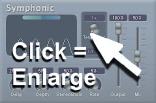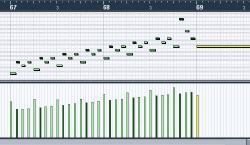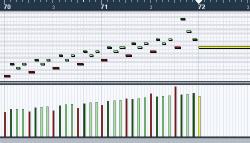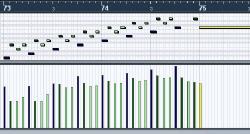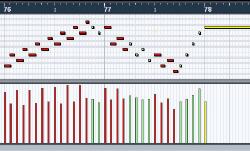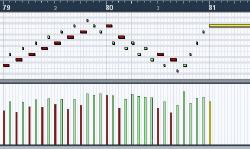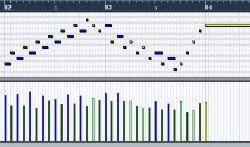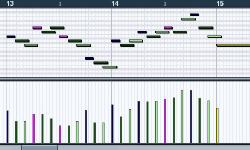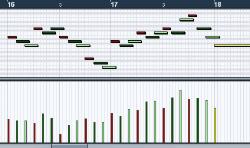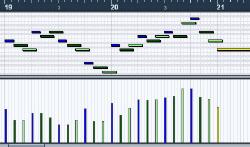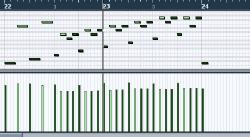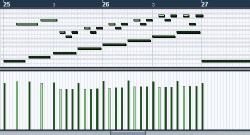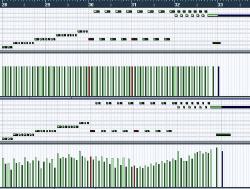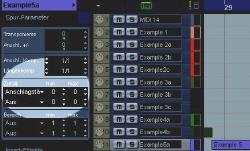VI SHORT NOTES
This tutorial is optimized for using with the new Vienna Instruments (VI). If you are using VSL's First- and Pro Edition or Horizon products: Go to VSL SHORT NOTES
And finally:
Enlarge the pictures by clicking on them!
How to handle VI SHORT NOTES
Dear VSL-user
The following pictures, texts and sound examples will show you the way.
Yours
Beat Kaufmann
____________________________________________________________________________
Introduction
One of the problems of sampling-music is the fight against a static, monotonous and dead sound. There are a lot of little tricks to fight this battle. With VSL we got such a lot of possibilities that „we do not see the wood for the trees“.
For that reason this tutorial will show you a few of these little tricks and ways to get the knacks. It’ll be the summary of two years using VSL and finding out cunning techniques. As you may know I have been playing the Violin for more than twenty years. This circumstance often helps me for searching the "right sample type" to reach the expected sounds.
Additional information for the VI-user
1. You can't see any keyswitches with the score examples. So choose the corresponding sample articulations by yourself.
2. VSL's SHORT NOTES where called "stac / 0,3s / 0,5s" in the Horizon Products and the Pro Edition. With the new VI the SHORT NOTES names have changed to "staccato / detache short / detache medium" .For some instruments exist also a detache long (~ 1s-2s). I didn't change the old indication. Perhaps it helps in some cases to know the time conditions.
3. One short remark at the end of this introduction: Sometimes you need to have an acute hearing to notice the subtle differences between the examples.
Contents
Jump directly to a title by clicking on it.
1. Emphasizing short notes
2. Handling fast legato notes
3. Using of stac- / 0,3s- / 0,5s- files
4. Playing the whole sample
5. Changing velocities
6. Using xx-1 and xx-2 samples ?
Services
Tip: There is a "printout - function" of this tutorial.
____________________________________________________________________________
1. Emphasizing short notes
Even if music lives for itself by fast played notes, nevertheless it sounds boring and sterile and like a machine, if you don't add a human touch in longer played parts. That means to vary the tempo, the volume or the playing style.
The first example shows a first possibility: Setting emphasis on short notes.
Click for Short Notes Example 1 [408 KB]
(Part 1 - Part 3)
or play:
Back to the Top
____________________________________________________________________________
2. Handling fast legato notes
"In pairs bounded" notes are not difficult for the VI - even if it contains fast legatos - but for its result to pass the test with our ears. Because of that reason, VSL has directly recorded runs, grace-notes and so on. The current VSL-legato performances are created to sound great for playing our phrase example under one bind (slur/bow). Listen to Part 1a Example 2. But whith the "Perf-Leg" performance-result, as written in the score, I'm not satisfied: The sound comes along with a lot of noise, rough and unfeeling. That's why the tool has to choose for the first note in the pair a starting note and only just now it selects the legato notes. That's correct. But in our case, where ever a second note is a legato-start-note it seems to be not a good application of Perf-Leg-samples (Part1b).
So let's try to simulate the legato:
The trick is to simulate this legato(s) by taking our good old sfz samples for fast phrases and 0,3s-files for slower phrases.
Listen to sound example 2:
Part 1a = legato one slur (no sequencer picture)
Part 1b = legato as written in the score of example 2
Part 2 = legato simulated with sfz-stac / sfz - stac / sfz - stac ...
Part 3 = legato simulated with 0,3s - stac / 0,3s -stac / 0,3s ...
Click for Short Notes Example 2 [518 KB]
(Part 1a/b - Part 3)
or play:
Back to the Top
____________________________________________________________________________
3. Using of stac- / 0,3s- / 0,5s- files
Combining short-note-samples gives life to fast played music parts too. Example 3 shows this tip in three ways. I personally love the 0,3s and 0,5s samples. Most of them are recorded in 3-4 dynamic layers. Further on: The p and mf samples are played in a soft, sensitive and expressive way whereas the f and ff samples are played powerful and intense. Please listen to the example for that.
Click for Short Notes Example 3 [553 KB]
(Part 1 - Part 3)
or play:
Back to the Top
____________________________________________________________________________
4. Playing the whole sample
With string instruments we sometimes have the situation, that the melody is played over two, three or even four strings. Specially the strings of instruments like cellos or double basses die away for a long time. So when you play for example alternate notes on different strings (like it happens in our example) then the only just played string sounds on and dies away in reality. We can have this effect too - also with short notes. Try staccato tones of different instruments. Although they sound in short ways, the VSL-stuff has also recorded the "fade-out-part" where it was
necessary (as I already mentioned you will often find it with instruments playing in the lower registers).
Attention: If the followed note is the same you may not overlap them. The VI choose the second version of the articulation (stacc2 for example) but it can't play overlapping tones yet > like HALion, Gigastudio.
Click for Short Notes Example 4 [295 KB]
(Part 1 - Part 2)
or play:
Back to the Top
____________________________________________________________________________
5. Changing velocities
This tip is based on a sequence like you have with Handel’s Aria from Messiah: "Why do the nations". The orchestra plays only fast staccatos. So you have a repetition of this sample type hundreds of times. Taking repetition samples (spiccato) you have the advantage of really no gun effect. But you have only two-level-samples. Taking staccato samples (single notes) you have the advantage of 4 sample levels. Listen to the following staccato-examples....
Click for Short Notes Example 5 [621 KB]
(Part 1 - Part 3)
or play:
Back to the Top
____________________________________________________________________________
6. Using xx-1 and xx-2 samples ?
You can't choose for example the up and down stroke of strings with the new VI. It does it by itself. So if you have select the staccato articulation and the instrument should pla the same note more then one time in a row it changes between stacc1 and stacc2. In othe words: Forget stacc1 and stacc2.
I suggest to use more the performance samples. For example: They will select - if you want - "spic/stac/det" by your playing speed. Try also Performance Repetitions...
Back to the Top
____________________________________________________________________________
And finally...
|
A user application: perf-repetition (detache medium) What do we do this work for? I would say to play music instead of technique, don't we? It is great to have an own orchestra, isn't it? |

|
Click for Short Notes Final [575 KB]
or play:
Aria, Johannes Passion
or... J.S. Bach:
Cantata BWV 29, Sinfonia
Back to the TOP
____________________________________________________________________________
Epilogue
Dear VSL-user
As always this tutorial is not the Short-Notes-Bible. It shows some possibilities how to use short notes in different ways. And why? For the very reason to fight against a static and technical sound. Fortunately fast played music lives by speed, unrest, noise and drive. But in all the previous examples you can notice more or less: Between music and static
played short sample parts are worlds apart.
I hope that this tutorial about the handling of short notes will encourage you to add further valuable information in the VSL Forum.
Link to the VSL-Forum
This tutorial tried to give some ideas how to come closer to music with samples of short notes. To sum up and give some recipes one can say:
1. Often change the velocity (with lots of equal notes > best between every note)
2. Use and combine different types of short notes (stac / 0,3s / 0,5s / perf_pep ...)
3. Set some musical accents in a couple of short notes (also with sfz samples)
4. Where it makes sense let the samples die away (Example 4)
5. Generally in music: Vary the tempo
I wish you successful results while working with short-notes-samples.
Yours
Beat Kaufmann
____________________________________________________________________________
Services
Tutorial as Document?
Please use the Printable Version - function at the Top
____________________________________________________________________________
Counter / Statistic
On this page you have been visitor:
Today: 1 / Total: 5037
____________________________________________________________________________
Back > Top
___________________________________________________________________________
© Copyright by Beat Kaufmann, 2004 - 2007

